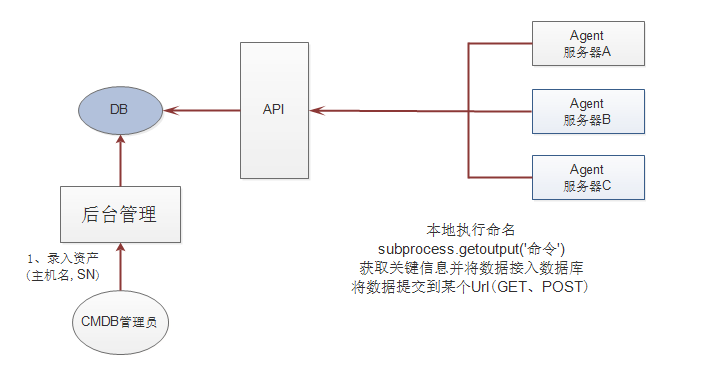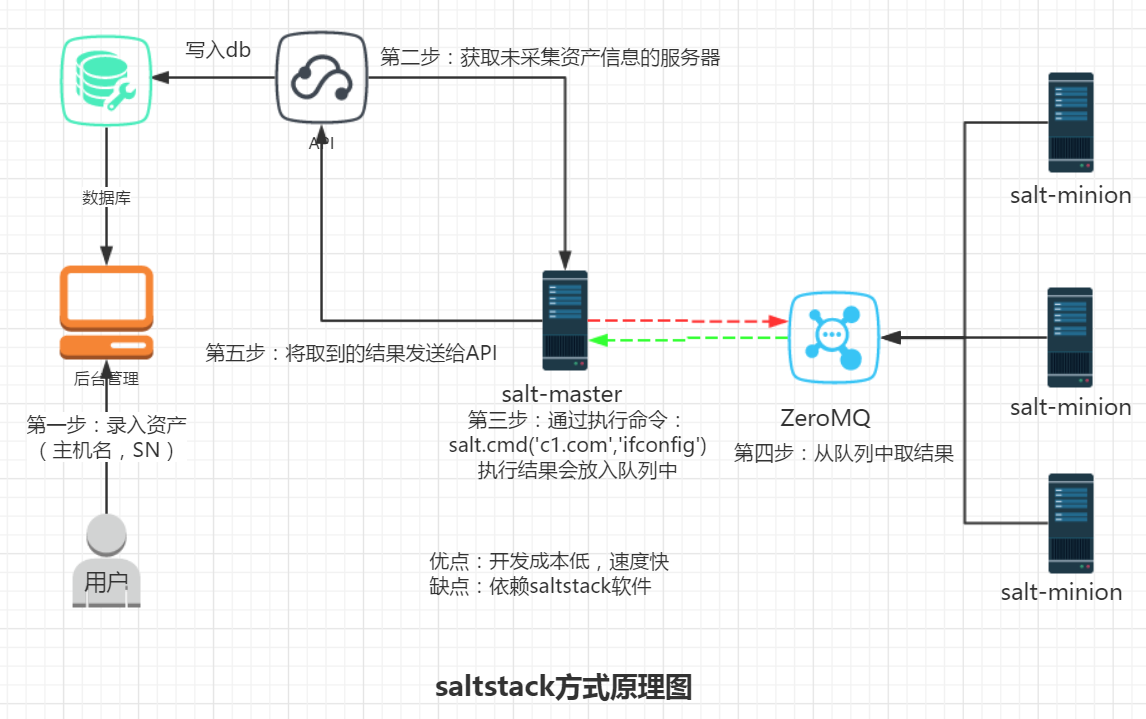CMDB服务器管理系统【s5day88】:采集资产之Agent、SSH和Salt模式讲解
在对获取资产信息时,简述有四种方案。
1、Agent (基于shell命令实现)

原理图
Agent方式,可以将服务器上面的Agent程序作定时任务,定时将资产信息提交到指定API录入数据库
优点:速度快 缺点:需要为每台服务器部署一个Agent程序
2、Paramiko类 (SSH形式,基于Paramiko模块)

中控机在获取未采集资产信息的服务器(服务器主机名,密码),依赖于Paramiko(py模块)通过SSH方式去获取
优点:无Agent 缺点:速度慢
如果在服务器较少的情况下,可应用此方法
|
1
2
3
4
5
6
7
8
9
10
11
12
13
14
15
16
|
import paramiko # 创建SSH对象ssh = paramiko.SSHClient()# 允许连接不在know_hosts文件中的主机ssh.set_missing_host_key_policy(paramiko.AutoAddPolicy())# 连接服务器ssh.connect(hostname='c1.salt.com', port=22, username='wupeiqi', password='123') # 执行命令stdin, stdout, stderr = ssh.exec_command('df')# 获取命令结果result = stdout.read() # 关闭连接ssh.close() |
3、SaltStack

此方案本质上和第二种方案大致是差不多的流程,中控机在获取到未采集资产信息的服务器(主机名),再而将命令放入一个队列中,服务器来获取。服务器将结果放入另一个队列中,中控机获取将服务信息发送到API进而录入数据库。
基于SaltStack的master上的pillar以及远程执行命令实现
|
1
2
3
|
import salt.clientlocal = salt.client.LocalClient()local.cmd('*', 'cmd.run', ['whoami']) |
优点:快,开发成本低 缺点:依赖于第三方工具
4、Puppet(ruby语言开发)
基于Puppet的factor和report功能实现
|
1
2
3
4
5
6
7
8
9
10
11
12
13
14
15
16
17
18
19
20
21
22
|
puppet中默认自带了5个report,放置在【/usr/lib/ruby/site_ruby/1.8/puppet/reports/】路径下。如果需要执行某个report,那么就在puppet的master的配置文件中做如下配置:######################## on master ###################/etc/puppet/puppet.conf[main]reports = store #默认#report = true #默认#pluginsync = true #默认####################### on client #####################/etc/puppet/puppet.conf[main]#report = true #默认 [agent]runinterval = 10server = master.puppet.comcertname = c1.puppet.com如上述设置之后,每次执行client和master同步,就会在master服务器的 【/var/lib/puppet/reports】路径下创建一个文件,主动执行:puppet agent --test |
1、自定义factor示例
|
1
2
3
4
5
6
7
8
9
10
11
12
13
14
15
16
17
18
19
20
21
22
23
24
25
26
27
28
29
30
31
32
33
34
35
36
37
38
39
40
41
42
43
44
45
|
在 /etc/puppet/modules 目录下创建如下文件结构:modules└── cmdb ├── lib │ └── puppet │ └── reports │ └── cmdb.rb └── manifests └── init.pp################ cmdb.rb ################# cmdb.rbrequire 'puppet'require 'fileutils'require 'puppet/util' SEPARATOR = [Regexp.escape(File::SEPARATOR.to_s), Regexp.escape(File::ALT_SEPARATOR.to_s)].join Puppet::Reports.register_report(:cmdb) do desc "Store server info These files collect quickly -- one every half hour -- so it is a good idea to perform some maintenance on them if you use this report (it's the only default report)." def process certname = self.name now = Time.now.gmtime File.open("/tmp/cmdb.json",'a') do |f| f.write(certname) f.write(' | ') f.write(now) f.write("\r\n") end endend################ 配置 ################/etc/puppet/puppet.conf[main]reports = cmdb#report = true #默认#pluginsync = true #默认 |
小结:
- 采集资产信息有四种不同的形式(但puppet是具于ruby开发的)
- API提供相关处理的接口
- 管理平台为用户提供可视化操作
三种方法对比表
作者:罗阿红
出处:http://www.cnblogs.com/luoahong/
本文版权归作者和博客园共有,欢迎转载,但未经作者同意必须保留此段声明,且在文章页面明显位置给出原文连接。


 浙公网安备 33010602011771号
浙公网安备 33010602011771号